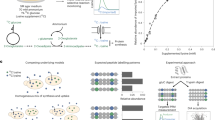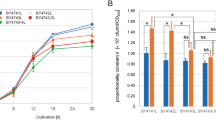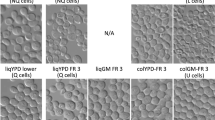Abstract
The carotenoid pigment astaxanthin (3,3′-dihydroxy-β,β-carotene-4,4′-dione) is an important component in feeds of aquacul-tural animals. It is produced as a secondary metabolite by the yeast Phaffia rhodozyma, and the isolation of rare mutants that produce increased quantities is limited by the lack of genetic selections. As a model system for enriching mutants increased in production of secondary metabolites, we have used quantitative flow cytometry/cell sorting (FCCS) to isolate astaxanthin hyperproducing mutants of the yeast. Experimental conditions were developed that gave a quantitative correlation of fluorescence and carotenoid content. In mutated populations, a 10,000-fold enrichment of carotenoid-overpro-ducing yeasts was obtained. Distinctive differences were detected by FCCS in fluorescence and forward scatter values of mutant and wild-type populations of yeasts. Comparison of wild-type and mutant clones by fluorescence confocal laser microscopy showed that the mutants had more intense fluorescence throughout the cell than the wild-type. Quantitative FCCS is a sensitive method to isolate and characterize carotenoid overproducing mutants and should be useful as a general method for the isolation of mutants increased in other fluorescent metabolites.
This is a preview of subscription content, access via your institution
Access options
Subscribe to this journal
Receive 12 print issues and online access
$209.00 per year
only $17.42 per issue
Buy this article
- Purchase on Springer Link
- Instant access to full article PDF
Prices may be subject to local taxes which are calculated during checkout
Similar content being viewed by others
References
Phaff, H.J., Miller, M.W., Yoneyama, M. and Soneda. M. 1972. A comparative study of the yeast florae associated with trees on the Japanese Islands and on the West Coast of North America, p. 759–774. In: Proceedings of the 4th IFS: Fermentation Technology Today. Terui, G. (Ed.). Society of Fermentation Technology, Kyoto, Osaka.
Miller, M.W., Yoneyama, M. and Soneda, M. 1976. Phaffia, a new yeast genus in the Deuteromycotina (Blastomycetes) . Int. J. Syst. Bacteriol. 26: 286–291.
Andrewes, G., Phaff, H.J. and Starr, M.P. 1976. Carotenoids of Phaffia rhodozyma, a red-pigmented fermenting yeast. Phytochem. 15: 1003–1007.
Johnson, E.A., Conklin, D.E. and Lewis, M.J. 1977. The yeast Phaffia rhodozyma as a dietary pigment source for salmonids and crustaceans. J. Fish. Res. Board Can. 34: 2417–2421.
Johnson, E.A., Villa, T.G., Lewis, M.J. and Phaff, H.J. 1978. Simple method for the isolation of astaxanthin from the basidiomycetous yeast Phaffia rhodozyma . Appl. Environ. Microbiol. 35: 1155–1159.
Johnson, E.A. and Lewis, M.J. 1979. Astaxanthin formation by the yeast Phaffia rhodozyma . J. Gen. Microbiol. 115: 173–183.
Johnson, E.A., Villa, T.G. and Lewis, M.J. 1980. Phaffia rhodozyma as an astaxanthin source in salmonid diets. Aquaculturc 20: 123–134.
Johnson, E.A., Lewis, M.J. and Grau, C.R. 1980. Pigmentation of egg yolks with astaxanthin from the yeast Phaffia rhodozyma . Poultry Sci. 59: 1777–1782.
Crueger, W. and Crueger, A. 1989. Biotechnology: A Textbook of Industrial Microbiology. Science Tech., Inc., Madison, WI.
Udenfriend, S. 1962. Fluorescence Assay in Biology and Medicine. Academic Press, New York.
Betz, J.W., Aretz, W. and Härtel, W. 1984. Use of flow cytometry in industrial microbiology for strain improvement programs. Cytometry 5: 145–150.
Bruschi, C.V. and Chuba, P.J. 1988. Nonselective enrichment for yeast adenine mutants by flow cytometry. Cytometry 9: 60–67.
Muirhead, K.A., Horan, P.K. and Poste, G. 1985. Flow cytometry: present and future. Bio/technology 3: 337–356.
An, G.-H., Schuman, D.B. and Johnson, E.A. 1989. Isolation of Phaffia rhodozyma mutants with increased astaxanthin content. Appl. Environ. Microbiol. 55: 116–124.
Davies, B.H. 1976. Carotenoids, p. 38–165. In: Chemistry and Biochemistry of Plant Pigments. Goodwin, T. W. (Ed.). Academic Press, London.
Brown, S.C., Jullien, M., Coutos-Thevenot, P., Muller, P. and Renau-din, J.-P. 1986. Present developments of flow cytometry in plant biology. Biol. of the Cell 58: 173–178.
Author information
Authors and Affiliations
Rights and permissions
About this article
Cite this article
An, GH., Bielich, J., Auerbach, R. et al. Isolation and Characterization of Carotenoid Hyperproducing Mutants of Yeast by Flow Cytometry and Cell Sorting. Nat Biotechnol 9, 70–73 (1991). https://doi.org/10.1038/nbt0191-70
Received:
Accepted:
Issue Date:
DOI: https://doi.org/10.1038/nbt0191-70
This article is cited by
-
Enhancement of carotenoid production in the new carotenoid-producing photosynthetic bacterium Rhodopseudomonas faecalis PA2
Biotechnology and Bioprocess Engineering (2015)
-
Assessment of β-carotene content, cell physiology and morphology of the yellow yeast Rhodotorula glutinis mutant 400A15 using flow cytometry
Journal of Industrial Microbiology and Biotechnology (2013)
-
Biotechnology of non-Saccharomyces yeasts—the basidiomycetes
Applied Microbiology and Biotechnology (2013)
-
Biotechnological production of astaxanthin with Phaffia rhodozyma/Xanthophyllomyces dendrorhous
Applied Microbiology and Biotechnology (2011)
-
Xanthophyllomyces dendrorhous for the industrial production of astaxanthin
Applied Microbiology and Biotechnology (2010)



